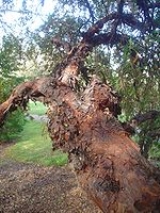
Polylepis australis
Encyclopedia
- "Tabaquillo" redirects here; it means "small tobaccoTobaccoTobacco is an agricultural product processed from the leaves of plants in the genus Nicotiana. It can be consumed, used as a pesticide and, in the form of nicotine tartrate, used in some medicines...
" and is also used for Nicotiana obtusifoliaNicotiana obtusifoliaNicotiana obtusifolia, or desert tobacco, is a plant native to the southwestern United States and Mexico....
.
Polylepis australis, also known locally as Tabaquillo or Queñoa is a tree endemic of central Argentina
Argentina
Argentina , officially the Argentine Republic , is the second largest country in South America by land area, after Brazil. It is constituted as a federation of 23 provinces and an autonomous city, Buenos Aires...
, member of the family Rosaceae
Rosaceae
Rosaceae are a medium-sized family of flowering plants, including about 2830 species in 95 genera. The name is derived from the type genus Rosa. Among the largest genera are Alchemilla , Sorbus , Crataegus , Cotoneaster , and Rubus...
. The genus Polylepis originated in the eastern South America, Andean forests . The plant has small, pinnate
Pinnate
Pinnate is a term used to describe feather-like or multi-divided features arising from both sides of a common axis in plant or animal structures, and comes from the Latin word pinna meaning "feather", "wing", or "fin". A similar term is pectinate, which refers to a comb-like arrangement of parts...
leaves, 7–10 cm long, normally composed of five or seven leaflets. In harsh winters, Polylepis australis survives by producing rolls of loose, papery like exfoliating brownish bark; the rough outer covering of the woody stem of tree. The southernmost stands of Polylepis australis are located in the high Córdoba
Córdoba Province (Argentina)
Córdoba is a province of Argentina, located in the center of the country. Neighboring provinces are : Santiago del Estero, Santa Fe, Buenos Aires, La Pampa, San Luis, La Rioja and Catamarca...
mountains of central Argentina (1,200–2,884 m above sea level).
South American Polylepis
Polylepis
Polylepis is a genus containing about twenty species of shrubs or trees native to the mid- and high-elevation regions of the tropical Andes. This group is unique in the rose family in that it is predominantly wind-pollinated. They are usually gnarled in shape, but in certain areas some trees are...
mountain forests are recognised as being one of the most endangered forest ecosystems in the world. During a reforestation
Reforestation
Reforestation is the natural or intentional restocking of existing forests and woodlands that have been depleted, usually through deforestation....
project, D. Renison (University of Córdoba
National University of Córdoba
The National University of Córdoba, , is the oldest university in Argentina, and one of the oldest in the Americas. It is located in Córdoba, the capital of Córdoba Province. Since the early 20th century it has been the second largest university in the country in terms of the number of students,...
, Argentina) found that the germination
Germination
Germination is the process in which a plant or fungus emerges from a seed or spore, respectively, and begins growth. The most common example of germination is the sprouting of a seedling from a seed of an angiosperm or gymnosperm. However the growth of a sporeling from a spore, for example the...
of Polylepis australis stands decreases significantly with decreasing tree coverage . The first results of additional studies carried out in collaboration with Isabell Hensen (University of Halle, Germany) indicate that a clear negative correlation
Negative relationship
In statistics, a relationship between two variables is negative if the slope in a corresponding graph is negative, or—what is in some contexts equivalent—if the correlation between them is negative...
exists between the viability of seeds of Polylepis australis and the degree of human influence on the woodland stands. Seeds of Polylepis australis exhibited a great variation in terms of mass and percent seed germination among individual trees and among geographical regions.

